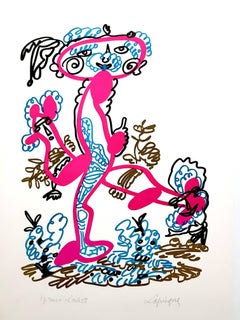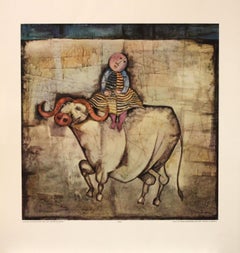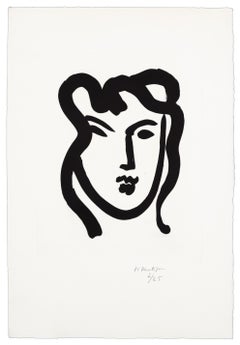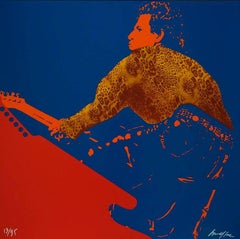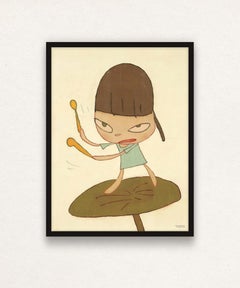Portrait Prints
to
1,899
3,664
1,496
1,741
1,079
751
Overall Width
to
Overall Height
to
2,237
1,947
816
387
326
212
167
165
131
120
96
15
12
10
269
172
108
97
92
348
1,514
4,452
2,443
64
135
185
163
239
244
486
862
646
305
285
6,631
1,560
509
6,527
3,595
3,101
2,613
1,932
1,555
1,221
1,137
946
793
757
417
379
363
246
215
200
189
176
169
3,135
1,853
1,587
899
771
1,281
3,410
4,861
2,771
Portrait Prints For Sale
Charles Lapicque (after) - Homage to Dufy - Lithograph
Located in Collonge Bellerive, Geneve, CH
Charles Lapicque
Original Handsigned Lithograph
Dimensions: 56 x 38 cm
Edition: Epreuve d'Artiste
Hand Signed
Charles Lapicque was one of the great painters of the “Ecole de Paris...
Category
1960s Modern Portrait Prints
Materials
Lithograph
Der Weisse Büffel. Printed in Germany.
Located in Chesterfield, MI
Print. Measures 20.75 x 19.5 inches and is Unframed. Good Condition.
Category
1970s Portrait Prints
Materials
Lithograph
$160 Sale Price
20% Off
Patitcha
Located in London, GB
Henri Matisse
Patitcha
1947
Aquatint on BFK Rives paper, Edition of 25
Paper size: 55.5 x 38 cms (22 x 15 ins)
Image size: 34.9 x 27.6 cm (13 3/4 x 10 7/8 ins)
HM15405
Selected Coll...
Category
1940s Modern Portrait Prints
Materials
Aquatint
$100,000
The Rolling Stones : Keith Richards - Original handsigned silkscreen - 85 copies
By Ivan Messac
Located in Paris, IDF
Ivan MESSAC
The Rolling Stones : Keith Richards, 2012
Original silkscreen
Signed by the artist bottom right
Numbered / 85 copies
Size 20 x 20 in (50 x 50 cm)
INFORMATION : This sil...
Category
2010s Contemporary Portrait Prints
Materials
Screen
Marching on a Butterbur Leaf (Black Box Framed)
Located in Manchester, GB
Yoshitomo Nara, Marching on a Butterbur Leaf, 2020
Offset lithograph
80# Classic Linen Solar White Cover
50 x 66 cm (19.69 x 25.98 in)
Open edition
Pristine condition accompani...
Category
2010s Contemporary Portrait Prints
Materials
Offset
Human Faces Abstract Collection - HFC 29 - Limited Edition Textured Canvas Print
By Irena Orlov
Located in Sherman Oaks, CA
Faces Abstract Collection by Irena Orlov
Introducing "Abstract Cubist Portrait - Human Faces Abstract Collection - HFC 29" - Limited Edition Textured Canvas Print
"Abstract Cubist ...
Category
2010s Cubist Portrait Prints
Materials
Canvas, Paint, Cotton Canvas, Mixed Media, Acrylic, Digital, Inkjet, Giclée
Kees van Dongen - Portrait - Original Lithograph
Located in Collonge Bellerive, Geneve, CH
Kees van Dongen - Portrait - Original Lithograph
1950
Signed in the plate
Dimensions: 22 x 16 cm
Publisher: Sauret.
From The Gods Are Athirst
Category
1950s Abstract Expressionist Portrait Prints
Materials
Lithograph
Manhattan Mary II (framed hand signed serigraph)
By Erté
Located in Aventura, FL
Serigraph in colors on paper. Hand signed and numbered on front by Erte. From the edition of 300. Artwork size 23.25 x 16.5 inches. Framed size approx 29 x 23 inches.
Artwork is...
Category
1980s Art Deco Portrait Prints
Materials
Paper, Screen
$1,715 Sale Price
30% Off
Erotic - Etching by Chas Laborde - 1920s
By Chas Laborde
Located in Roma, IT
Erotic is an original etching by Chas Laborde in the 1920s. This original print is hand-colored in watercolor.
In very good condition, including white cardboard Passepartout, 52 x 37cm.
This artwork belongs to the erotic series of Chas Laborde in which you recognize his authentic style of illustration.
Chas Laborde (Buenos Aires, 1886 - Paris, 1941)
Charles Laborde...
Category
1920s Portrait Prints
Materials
Etching
Still Life - Lithograph
Located in Collonge Bellerive, Geneve, CH
(after) Raoul Dufy
Lithograph after a watercolor, published in the book "Lettre à mon peintre Raoul Dufy." Paris, Librairie Académique Perrin, 1965.
Printed signature
Di...
Category
1940s Fauvist Portrait Prints
Materials
Lithograph
Raoul Dufy (after) - Lithograph
Located in Collonge Bellerive, Geneve, CH
(after) Raoul Dufy
Lithograph after a watercolor, published in the book "Lettre à mon peintre Raoul Dufy." Paris, Librairie Académique Perrin, 1965.
Printed signature
Di...
Category
1940s Fauvist Portrait Prints
Materials
Lithograph
Sniggling for Eel
Located in Middletown, NY
Etching with drypoint in black ink on antique laid paper with various large watermarks, 6 3/4 x 5 3/8 inches (172 x 132 mm), full margins with deckle edges on two sides. Signed, date...
Category
Mid-20th Century American Realist Portrait Prints
Materials
Laid Paper, Drypoint, Etching
Playboy August 1962
Located in Nottingham, GB
This is a unique silkscreen colour-way, original work on paper, with a spot diamond dust finish. Signed by Simon Claridge and emboss stamped by Playboy.
...
Category
2010s Contemporary Portrait Prints
Materials
Screen
Peter (Keeper of the Keys)
Located in Washington, DC
Artist: Salvador Dali
Title: Peter (Keeper of the Keys)
Portfolio: 1972 The Twelve Apostles (Knights of the Round Table)
Medium: Lithograph
Year: 1972
Edition: 41/350
Frame Size: 29 ...
Category
1970s Surrealist Portrait Prints
Materials
Lithograph
Original pre-release 'Indiana Jones and the Temple of Doom' vintage poster
Located in Spokane, WA
Original movie poster, Linen-backed original Indiana Jones and the Temple of Doom pre-release. "Coming May 23rd, 1984.
Indiana Jones and the Temple of Doom, the 1984 Steven Spielberg treasure-hunting action-adventure fantasy sequel ("If adventure has a name... It must be Indiana Jones."; "Trust him."
Starring: Harrison Ford, Kate Capshaw, Jonathan Ke Quan, Amrish Puri, Roshan Seth, Philip Stone...
Category
1980s American Modern Portrait Prints
Materials
Offset
$476 Sale Price
20% Off
Hommage a Christian Dior original French vintage fashion poster
By René Gruau
Located in Spokane, WA
Original vintage French poster: Christian Dior Homage. (Homage à Christian Dior)
Artist: Rene Gruau. Mint condition Original.
Size: 15.75" x 24" Very fine condition; read...
Category
1980s American Realist Portrait Prints
Materials
Offset
Christ on the Cross-Framed (Reproduction) Print
Located in Chesterfield, MI
Measures 19.25 x 17.5 inches with frame and matting. Image is in Good Condition. Frame and casing are in Fair/Distressed Condition-signs of wear consistent with age and handling (i.e...
Category
Late 20th Century Portrait Prints
Materials
Lithograph
$280 Sale Price
20% Off
David Ascending the Mount of Olives
By Marc Chagall
Located in Washington, DC
Artist: Marc Chagall
Medium: Original lithograph on Arches wove paper
Title: David Ascending the Mount of Olives
Portfolio: Signed Bible Etchings with Watercolor
Year: 1958
Edition: ...
Category
1960s Portrait Prints
Materials
Lithograph
Original Pompe Caruelle - water pump, vintage French antique poster
Located in Spokane, WA
Original linen-backed fun vintage poster "POMPE CARUELLE" full lithograph from 1924. Printed by Gaillard, Paris, France. Linen baked in very fine condition, A-.. Ready to Frame.
The image features a boy showing how easy the new Pomjpe Caruelle is to use, able to work it with just one hand. Above him are featured an American Indian, a Chinese man, a Man in a green hat, and an African with large earrings and a nose ring...
Category
1920s Conceptual Portrait Prints
Materials
Lithograph
Tomano Monote (Cupcake Boy)
Located in Palm Springs, CA
Alejandro Colunga is a renowned Mexican artist born in 1948 in Guadalajara, Jalisco. He is part of the Nueva Mexicanidad movement and is celebrated for his surrealist and fantastical...
Category
1990s Surrealist Portrait Prints
Materials
Etching, Gouache, Aquatint
Carmen, The Smiling Face - Original Etching (Cramer #52)
Located in Paris, IDF
Pablo PICASSO
Carmen, The Smiling Face, 1949
Original burin engraving (Atelier Lacourière, Paris)
Unsigned
On Montval wove paper 33 x 26 cm (12.9 x 10.2 in)
REFERENCES :
- Catalog...
Category
1940s Modern Portrait Prints
Materials
Etching
"The Two Sisters" lithograph
Located in Henderson, NV
Medium: lithograph (after the painting). Printed in Paris on smooth wove paper at the atelier Mourlot and published in 1954. Size: 6 1/2 x 8 inches (168 x 202 mm). Not signed.
Cond...
Category
1950s Portrait Prints
Materials
Lithograph
Pantocrator - Christ In His Majesty (Tarot 3 of Coins), hand signed lithograph
Located in Aventura, FL
Lithograph and mezzotint on japon paper. Hand signed and numbered by Salvador Dali. LXXXIX/C. Includes original portfolio and insert. Published by Levine and Levine Publishers for Beverly Hills Gallery. A. Field 76-7, p. 131.
Catalogue Raisonné: Field 76-7, pp. 131.
Artwork is in excellent condition. All reasonable offers will be considered.
About the Artist: Salvador Dalí (Spanish, 1904–1989) was a renowned Surrealist artist known for his enigmatic paintings of dreamscapes and religious themes. The Persistence of Memory (1931), arguably his best known work, visually manifests the strangeness of time, showing clocks melting in an idyllic landscape. “One day it will have to be officially admitted that what we have christened reality is an even greater illusion than the world of dreams,” he once reflected. Born Salvador Domingo Felipe Jacinto Dalí i Domènech on May 11, 1904 in Figueres, Spain, he displayed a great aptitude for the visual arts as a teenager. Three years after his first exhibition at the age of 14, he enrolled at the Academia de San Fernando in Madrid. At school, he emulated many contemporary styles but also the works of Johannes Vermeer and Diego Velázquez. During his visits to Paris in the late 1920s, he was introduced to the Surrealist movement by René Magritte and Joan Miró. Though the concept of Surrealism was new to him, Dalí was already well versed in the psychoanalytic theories of Sigmund Freud. Dabbling in various projects throughout his long career, in 1942 he published the book The Secret...
Category
1970s Surrealist Portrait Prints
Materials
Paper, Lithograph
Original 1890s Ambassadeurs Les Cinq Demi-Vierges vintage theater poster
Located in Spokane, WA
Original Ambassadeurs Les Cinq Demi-Vierges. Linen backed in B condition. It was folded at one time with the fold marks laid down during the linen backing process. There are som...
Category
1880s Art Nouveau Portrait Prints
Materials
Lithograph
Tom Wesselmann, 'Look at Wesselmann, Nude with Still Life' Poster, 1968
Located in Miami, FL
This vibrant Tom Wesselmann poster is original serigraph from 1968. Although in good condition, please note that there is foxing present.
Pleas...
Category
1960s Contemporary Portrait Prints
Materials
Color
"David and Absalom" original lithograph
By Marc Chagall
Located in Henderson, NV
Medium: original lithograph. Catalogue reference M 133. This beautiful color lithograph was printed by Mourlot and published in Paris by Teriade for Verve in 1956 for a special editi...
Category
1950s Portrait Prints
Materials
Lithograph
La commode, 1986, original lithograph by Jean Jansem, handsigned
By Jean Jansem
Located in Les Acacias GE, GE
Jean Jansem (1920-2013)
La commode, 1986
Lithographie sur papier Arches
Signée en bas à droite et justifiée en bas à gauche
51 x 70 cm / 54 x 76 cm
D'une édition à 30 exemplaires d...
Category
Late 20th Century Expressionist Portrait Prints
Materials
Lithograph
SHARING A MOMENT
By Pino Daeni
Located in Aventura, FL
Giclee on canvas. Hand signed and numbered on front by the artist. Canvas image size 40 x 30 in. Artwork is in excellent condition. Certificate of authenticity included. Edition of ...
Category
21st Century and Contemporary Contemporary Portrait Prints
Materials
Canvas, Giclée
$1,396 Sale Price
30% Off
"George Dyer Squatting" lithograph
Located in Henderson, NV
Medium: lithograph (after the painting). Printed in 1966 for Derriere le Miroir (issue number 162) and published in Paris by Maeght. This lithograph was done after the Francis Bacon ...
Category
1960s Surrealist Portrait Prints
Materials
Lithograph
Original Have a Beer Girl (pin up style) 1940s vintage poster
Located in Spokane, WA
Linen backed original beer poster without text. A beautiful woman is holding a large German style glass of beer; of course, with the appropriate amount of foam on top. A pin up...
Category
1940s Art Deco Portrait Prints
Materials
Lithograph
YOUNG MOTHER
By Irving Amen
Located in Aventura, FL
Serigraph on paper. Hand signed, titled and numbered by the artist. Edition of 200. Image size approx 14.75 x 11.75 inches. Custom framed as pictured. Artwork appears to be in exce...
Category
Late 20th Century Contemporary Portrait Prints
Materials
Paper, Screen
$450 Sale Price
40% Off
(Title Unknown)-Poster Featuring the Artwork of Hideki Fujii
Located in Chesterfield, MI
Poster. TIB Photo. Published by Avanti Press Detroit, Michigan. Measures 38 x 24 inches and is unframed. The piece is in Fair/Distressed Condition-indentation/surface abrasions due t...
Category
Late 20th Century Portrait Prints
Materials
Lithograph
$185 Sale Price
47% Off
Jean Cocteau - Marine Mountains - Original Lithograph
By Jean Cocteau
Located in Collonge Bellerive, Geneve, CH
Jean Cocteau - Marine Mountains - Original Lithograph
Dimensions: 38 x 28 cm
Edition: 200
In Rives
From: COCTEAU. — VERDET (André). Montagnes marines. S. l. (Paris), Les Messagers du...
Category
1960s Modern Portrait Prints
Materials
Lithograph
Olga Picasso, Cubist Lithograph after Pablo Picasso
Located in Long Island City, NY
In this print, Pablo Picasso portrays his former wife at the time seated in a wooden arm chair, with her hands clasped an her body turned to the side. Set against a muted blue background, the representation of Olga is formal and elegant, with her hair tied back into a chignon and her body clothed in neutral but rich fabric. A lithograph from the Marina Picasso Estate Collection after the Pablo Picasso painting "Olga Picasso...
Category
Late 20th Century Cubist Portrait Prints
Materials
Lithograph
''Marianne'' Limited edition print of surrealistic collage with diamond dust
By Maria Rivans
Located in Utrecht, NL
Maria Rivans is a contemporary British artist, known for her scrapbook-style collage aesthetic. A mash-up of Surrealism meets Pop-Art, Rivans’s work re-ap...
Category
2010s Contemporary Portrait Prints
Materials
Paper, Mixed Media
L'AFFECTATION
By Isaac Maimon
Located in Aventura, FL
Serigraph on paper. From Paris Nights Suite. Hand signed and numbered by the artist. Image size 18.5 x 15 inches.
Artwork is in excellent condition. Certificate of Authenticity is...
Category
Late 20th Century Contemporary Portrait Prints
Materials
Paper, Screen
$150 Sale Price
75% Off
Elizabeth Peyton, Camille Claudel Flowers and Books - Signed Print
Located in Hamburg, DE
Elizabeth Peyton (American, b. 1965)
Camille Claudel Flowers and Books, 2010
Medium: Etching on wove paper
Dimensions: 29 × 22 cm (11½ × 8¾ in)
Edition of 30 + 6 AP: Hand-signed, dat...
Category
21st Century and Contemporary Contemporary Portrait Prints
Materials
Etching
Follow your heart
Located in New York City, NY
Eduardo Recife
Follow your heart, 2018
Archival Pigment Print
Unframed
56 x 40 inches
Edition of 5
Category
2010s Contemporary Portrait Prints
Materials
Archival Pigment
"Invocation (L'Estampe Moderne I), " Original Color Lithograph by Marcel Lenoir
Located in Milwaukee, WI
"Invocation" is an original lithograph with the blindstamp of L'Estampe Moderne in the bottom right corner. L'Estampe Moderne commissioned Marcel Lenoir ...
Category
1890s Art Nouveau Portrait Prints
Materials
Lithograph
Paris Rue
Located in Sag Harbor, NY
JOHN CHAMBERLAIN
Paris Rue
1991
Ektacolor Professional print taken with Wide Lux camera
Unsigned
AP 1/1 apart from an edition of 9
24” x 20”
Chamberlain began to explore photogr...
Category
1990s Abstract Expressionist Portrait Prints
Materials
C Print
"Troupe de M'lle Eglantine" 1974 Albi Museum authorized limited edition poster
Located in Boca Raton, FL
"Troupe de M'lle Eglantine" 1974 reproduction of an 1896 poster by Henri Toulouse-Lautrec produced under the auspices of the Lautrec Museum in Albi, France. Authenticated with museum...
Category
1890s Post-Impressionist Portrait Prints
Materials
Lithograph
Ap-Pa-Noo-Se, A Saukie Chief: Original Hand-colored McKenney & Hall Lithograph
Located in Alamo, CA
This is an original 19th century hand-colored McKenney and Hall lithograph of a Native American entitled "Ap-Pa-Noo-Se, A Saukie Chief", lithographed by J. T. Bowen after a painting ...
Category
Mid-19th Century Naturalistic Portrait Prints
Materials
Lithograph
Nadia au visage rond
Located in London, GB
Henri Matisse
Nadia au visage rond
1948
Aquatint on Marais wove paper, Edition of 25
Paper Size: 60.2 x 46.4 cms (23 3/4 x 18 1/4 ins)
Image Size: 44.4 x 34.7 cms (17 1/2 x 13 5/8 in...
Category
1940s Modern Portrait Prints
Materials
Aquatint
The Spectacle Seller
By Adriaen Jansz van Ostade
Located in Middletown, NY
Etching and drypoint on cream laid paper, 4 x 3 3/8 inches (102 x 86 mm), 1/4 inch margins. Signed in the plate, lower left corner. The 3rd state (of 6), after the rounding of the pl...
Category
Mid-17th Century Old Masters Portrait Prints
Materials
Drypoint, Laid Paper, Etching
Origianal BARBARELLA US 1-sheet Sci-fi vintage movie poster NSS 68/274
By Robert McGinnis
Located in Spokane, WA
Original BARBARELLA US 1-sheet, 1968, sexiest sci-fi art of Jane Fonda by Robert McGinnis, Roger Vadim. Paramount Pictures. Size: 27" x 41"; year: 1968. NSS: 68/274
Film...
Category
1960s American Modern Portrait Prints
Materials
Offset
Mejor ed Holgar - Etching by Francisco Goya - 1855 ca
Located in Roma, IT
Etching drypoint and aquatint realized by Francisco Goya. Plate 73 from the Series "Los Caprichos".
Beautiful proof of 2nd Edition, printed in 1855 ca.
Includes a wooden frame cm. ...
Category
1850s Contemporary Portrait Prints
Materials
Etching
Lassitude
Located in New York, NY
Jean-Emile Laboureur, Lassitude, 1912, woodcut, signed and numbered (24/35) in pencil. Reference: Sylvain Laboureur 682, third state (of 3). From the edition of about 35, published b...
Category
1910s Cubist Portrait Prints
Materials
Woodcut
Poster-London Brighton Jog...
By Robert Weil
Located in Chesterfield, MI
ROBERT WEIL (American, b.1945). Poster-“London Brighton Jog…” August 10-11 Hyde Park. Plate signed. Measures 30 x 22 in. Unframed. Good Condition.
Category
Late 20th Century Portrait Prints
Materials
Screen
$120 Sale Price
20% Off
WPA Expressionist woodblock print. "The Worker"
Located in Surfside, FL
Pencil signed original limited edition woodcut woodblock print great depression era. from the 1930s.
Abramovitz, Albert 1879-1963
Born in Riga, Latvia, Abramovitz studied art at th...
Category
1930s Portrait Prints
Materials
Woodcut
WISH I MAY...
By Colleen Ross
Located in Aventura, FL
Hand signed and numbered by the artist. Serigraph on paper. Sheet size 40 x 27.5 inches. Image size 36.5 x 24 inches. Edition of 150.
Artwork is in excellent condition. Certifi...
Category
Late 20th Century Contemporary Portrait Prints
Materials
Paper, Screen
$650 Sale Price
50% Off
PALOMA PICASSO FS II.121
By Andy Warhol
Located in Aventura, FL
Paloma Picasso, from Hommage à Picasso. Screenprint in colors on Arches. Hand signed and numbered on verso by the artist. Published by Propyläen-Verlag, Berlin, and Pantheon Presse, ...
Category
1970s Pop Art Portrait Prints
Materials
Paper, Screen
HUMAN TERROR
Located in Aventura, FL
Giclée print on Moab Entrada 290gsm Cotton Rag paper with deckled edges. Hand signed and numbered by the artist. From the edition of 100.
Artwork is in excellent condition. Certif...
Category
2010s Street Art Portrait Prints
Materials
Paper, Giclée
$1,125 Sale Price
25% Off
WHAT PARTY (YELLOW)
By KAWS
Located in Aventura, FL
Screen print in colors on Saunders Waterford hi-white paper. Hand signed, dated and numbered by the artist. Edition 51/100 (there was also 20 APs and 5 PPs). Published by KAWSONE, B...
Category
21st Century and Contemporary Street Art Portrait Prints
Materials
Paper, Screen
$17,970 Sale Price
40% Off
CELEBRITY NIGHT AT SPAGO
By LeRoy Neiman
Located in Aventura, FL
Hand signed numbered by the artist. Framed size: approx. 37 x 49 in. Artwork is in excellent condition. Certificate of Authenticity included. Edition of 600. All reasonable offers w...
Category
1990s Impressionist Portrait Prints
Materials
Paper, Screen
$3,375 Sale Price
25% Off
SUPERMODEL 2
By KAWS
Located in Aventura, FL
Screen print in colors on Rives BFK wove paper. Hand signed, dated and numbered by the artist. Artwork size 29.2 x 21 inches. Custom framed as pictured. Frame size approx 34.5 x 2...
Category
1990s Street Art Portrait Prints
Materials
Paper, Screen
$47,970 Sale Price
40% Off
UNTITLED (SNOOPY)
By KAWS
Located in Aventura, FL
Screen print cutout on Saunders Waterford 425gm HP Hi-White paper. Hand signed, dated and numbered by the artist. Artwork size 10.5 x 8 inches. Custom framed as pictured. Frame si...
Category
21st Century and Contemporary Street Art Portrait Prints
Materials
Paper, Screen
$9,000 Sale Price
40% Off
Meeting of Jacob and Rachel
By Marc Chagall
Located in Washington, DC
Artist: Marc Chagall
Medium: Original lithograph on Arches wove paper
Title: Meeting of Jacob and Rachel
Portfolio: Signed Bible Etchings with Watercolor
Year: 1958
Edition: 81/100
S...
Category
1960s Portrait Prints
Materials
Lithograph
Untitled Gynoid Lenticular Edition Hajime Sorayama
Located in Draper, UT
In 2025, Avant Arte partnered with legendary Japanese artist Hajime Sorayama to release a groundbreaking lenticular print edition—a striking, kinetic homage to his iconic gynoid figu...
Category
2010s Portrait Prints
Materials
Lenticular
A Sinking Island Floating in a Sea Called Space set of 2
Located in Washington , DC, DC
Beautiful limited edition posters by Yoshitomo Nara for his exhibition at the Hammer Museum. Only available for a limited amount of time where they sold out quickly, edition size unk...
Category
2010s Contemporary Portrait Prints
Materials
Paper
Jean Cocteau - Jean Monnet's Vision - Original Lithograph
By Jean Cocteau
Located in Collonge Bellerive, Geneve, CH
Original Lithograph by Jean Cocteau
Title: Jean Monnet's Vision
Signed in the stone/printed signature
Dimensions: 33 x 46 cm
Edition: 200
Luxury print edit...
Category
1960s Modern Portrait Prints
Materials
Lithograph
